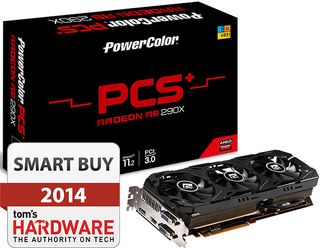PowerColor PCS+ R9 290X Review: Cool, Quiet, And Priced Right
PowerColor sent over a second 2.5-slot Hawaii-based card. The first was MSI's R9 290X Lightning. This one, the PCS+ R9 290X is both lighter and less expensive. Does PowerColor out-engineer MSI and score an upset, or is the PCS+ simply less capable?
Solid Performance And Pricing Come Together
PowerColor's PCS+ R9 290X currently sells for $600 on Newegg. That's about $30 higher than it was a week ago. Still, though, that's a good price for an overclocked card cooled by a third-party thermal solution. The cheapest R9 290X boards also equipped with non-reference heat sinks start around $570. And the least-expensive GeForce GTX 780 Tis go for $700.
After a drastic spike up in pricing and a slow pullback, we're finally ready to start recommending the Hawaii GPU-based flagship to enthusiasts looking for high-end performance, effective cooling, conservative acoustics, and a reasonable price tag.
The success of PowerColor's PCS+ R9 290X is partly attributable to market conditions, sure. But the board is also well-built. It's fast, light (given its size), fairly quiet, and, despite the fact that there are a number of pricier 290Xes, relatively affordable. There is but one minor piece of feedback we'd give to PowerColor: the automatic fan control is a bit course, cranking up rotational speed quickly once the GPU temperature hits 72 °C (162 °F). As a result, the PCS+ R9 290X isn't able to beat MSI's R9 290X Lightning in our acoustic test.
With that said, PowerColor successfully build a Radeon R9 290X that's as large and powerful as MSI's premium competition, weighing a full pound less. Yes, there are a couple of things the company could have done better, but we're nitpicking.
Conclusion
If you are back in the market for a Radeon R9 290X, having watched their prices dip back down into sane territory, PowerColor's PCS+ R9 290X is one of our favorite choices. The card doesn't suffer any debilitating flaws, but rather offers excellent gaming performance behind an effective cooler. And speaking of heat sink design, PowerColor's fits like a glove. The implementation would be tough to beat.

As we've seen, some competing vendors built their Radeon R9 290Xes in a hurry and missed the mark. Haste makes waste, so to speak. So, it looks like the long wait for PowerColor's card was worthwhile.
Stay on the Cutting Edge
Join the experts who read Tom's Hardware for the inside track on enthusiast PC tech news — and have for over 25 years. We'll send breaking news and in-depth reviews of CPUs, GPUs, AI, maker hardware and more straight to your inbox.
Current page: Solid Performance And Pricing Come Together
Prev Page Clock Rates, Temperature, And Sound Level-
CaptainTom I just want to point out that this and most 290X's beat a stock 780 Ti. The fact is both 780 Ti and the 290X are trade blows and belong on the same GPU tier. However only one does cost $150 less and come with 4GB VRAM...Reply -
Memnarchon Reply13232466 said:I just want to point out that this and most 290X's beat a stock 780 Ti. The fact is both 780 Ti and the 290X are trade blows and belong on the same GPU tier. However only one does cost $150 less and come with 4GB VRAM...
Well, since you are comparing a non reference GPU, you should take also a non-reference GPU to compare.
Tom's using Gigabyte's 780ti OC which costs the same as the reference card...
So even the non-reference models are on a different tier as well as their reference... -
FormatC Reply13232896 said:Any chance of measurements in metric as well as imperial?
Typical translation errors, the original is in metric ;)
http://www.tomshardware.de/powercolor-r9-290x-pcs-review,testberichte-241519-3.html4
I will clearify with Chris, that we use both in the future. Metric is worldwide more common :D -
dave_trimble Surprised the benchmark graph show performance at 1080p. Aren't the 290 series kind of wasted at that resolution? I would love to see the results at 1440p or even 4k. I have a feeling the 780ti might not look quite as good in comparison at higher resolution.Reply -
photonboy A stock GTX780Ti is 7% faster at 2560x1440, and 8% faster at 1920x1080 (18 games averaged):Reply
http://www.techpowerup.com/reviews/EVGA/GTX_780_Ti_SC_ACX_Cooler/26.html
With such a HUGE difference in prices, quality, and performance on all top-end cards you really have to do your research.
The R9-290X prices vary from $550 to $780 USD! -
dave_trimble Reply13233877 said:A stock GTX780Ti is 7% faster at 2560x1440, and 8% faster at 1920x1080 (18 games averaged):
http://www.techpowerup.com/reviews/EVGA/GTX_780_Ti_SC_ACX_Cooler/26.html
With such a HUGE difference in prices, quality, and performance on all top-end cards you really have to do your research.
The R9-290X prices vary from $550 to $780 USD!
Thanks for the response! I thought I had seen reviews elsewhere that showed the 290 series really closing the gap, or even surpassing the 780ti at higher resolutions, but perhaps I was remembering wrong. I recently decided to upgrade to a dual-290 setup, but if I had gone with a single card, the 780ti was at or near the top of my list (until the 290x prices came crashing down, that is).
-
That_Guy88 So is the difference between 290x's almost entirely due to cooling (and some OC)? I have someone who wants to sell me a reference 290x for $350, but I have a gtx 770, so it would seem that I would need to buy an after market cooler as well to make it worth my while. Thoughts?Reply -
vertexx Reply
See these articles for after-market cooling options:13234604 said:So is the difference between 290x's almost entirely due to cooling (and some OC)? I have someone who wants to sell me a reference 290x for $350, but I have a gtx 770, so it would seem that I would need to buy an after market cooler as well to make it worth my while. Thoughts?
Air cooling:
http://www.tomshardware.com/reviews/r9-290-accelero-xtreme-290,3671.html
Liquid Cooling:
How to:
http://www.pcper.com/reviews/Graphics-Cards/Using-NZXT-Kraken-G10-Watercool-Radeon-R9-290
And results:
http://www.tomshardware.co.uk/radeon-r9-290-and-290x,review-32872.html
Most Popular

